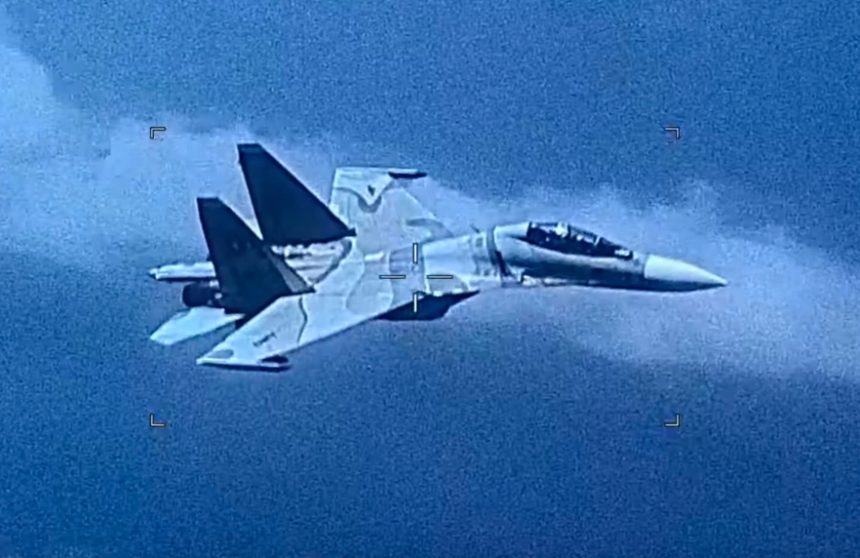Four videos released by U.S. Southern Command show the unarmed Venezuelan Air Force maneuvering around the U.S. spyplane.
The U.S. military has just released a series of four videos filmed by a U.S. Navy EP-3E ARIES II intercepted by a Venezuelan Air Force Su-30MKII Flanker in international airspace over the Caribbean Sea on Jul. 19, 2019.
According to U.S. Southern Command, the Russian-built multirole aircraft “aggressively shadowed” the EP-3E aircraft, flying at an unsafe distance from the interlligence gathering aircraft “jeopardizing the crew and aircraft.”
“The EP-3 aircraft, flying a mission in approved international airspace was approached in an unprofessional manner by the SU-30 that took off from an airfield 200 miles east of Caracas. The U.S. routinely conducts multi-nationally recognized and approved detection and monitoring missions in the region to ensure the safety and security of our citizens and those of our partners,” says the official statement that accompanies the footage filmed from the
This is not the first time such close encounters occur. Another similar one happened last year, on Jan. 29, 2018, when a U.S. EP-3 Aries aircraft flying in international airspace was intercepted by a Russian Su-27 over the Black Sea.
Here’s what we wrote back then about these alleged unprofessional intercept maneuvers performed by Russian or Chinese fighters on U.S. spyplanes. It’s useful as it recalls some of the previous interactions all around the world.
This is not the first time a Chinese or Russian fighter pilot performs a Top Gun-like stunt or aggressively maneuvers close to a U.S. aircraft.
In February 2017, a People’s Liberation Army Air Force KJ-200 and a U.S. Navy P-3 Orion aircraft were involved in what was defined by U.S. officials as an “unsafe” close encounter over the South China Sea.
Last year, on Apr. 29, 2016, a Russian Su-27 Flanker barrel rolled over the top of a U.S. Air Force RC-135 aircraft operating in the Baltic Sea. The Russian jet came within 25 feet of the U.S. intelligence gathering aircraft.
Another Su-27 had carried out the same dangerous maneuver on another US Rivet Joint over the Baltic on Apr. 14, 2016.
Previously, on Jan. 25, 2016 another U.S. RC-135 intelligence gathering jet was intercepted over the Black Sea by a Russian Su-27 Flanker that made an aggressive turn that disturbed the controllability of the RC-135.
On Apr. 7, 2015 another Su-27 flew within 20 feet of an RC-135U over the Baltic Sea.
On Apr. 23, 2015 a U.S. Air Force RC-135U Combat Sent performing a routine surveillance mission in international airspace over the Sea of Okhotsk, north of Japan, some 60 miles off eastern Russia was intercepted by a Russian Su-27 Flanker that crossed the route of the U.S. aircraft putting itself within 100 feet of the Combat Sent.
In 2014, a Chinese Flanker made a barrel roll over a U.S. Navy P-8 maritime surveillance plane 135 miles east of Hainan Island, a spot where a dangerous close encounter of another U.S. electronic surveillance plane with the Chinese Navy took place back in 2001: on Apr. 1, 2001, a U.S. Navy EP-3E with the VQ-1, flying an ELINT (Electronic Intelligence) mission in international airspace 64 miles southeast of the island of Hainan was intercepted by two PLAN (People’s Liberation Army Navy) J-8 fighters. One of the J-8s piloted by Lt. Cdr. Wang Wei, made two close passes to the EP-3 before colliding with the spyplane on the third pass. As a consequence, the J-8 broke into two pieces and crashed into the sea causing the death of the pilot, whereas the EP-3, severely damaged, performed an unauthorized landing at China’s Lingshui airfield.
The 24 crew members (21 men and three women), that destroyed all (or at least most of) the sensitive items and data on board the aircraft, were detained by Chinese authorities until Apr. 11.
Close encounters between Russian (previous Soviet) fighters and U.S. spyplanes and bombers (and viceversa) have occurred for decades now. Prior to the end of the Cold War interceptors from a variety of nations managed to get into tight formation with RC-135s, EP-3s and other U.S. planes. Smaller airplanes like MiG-21s made it easy. The challenge with the larger airplanes like the Su-27 or its derivative variant, such as the multirole Su-30, is the sheer size of the interceptor as it moves in front of any portion of the intercepted plane; but least a Flanker pilot has excellent all-around visibility to see where the back end of his own airplane is as he maneuvers adjacent to the RC-135, something that was limited in previous generations of Soviet interceptors.
A U.S. Air Force F-4 WSO (Weapons Systems Officer) recounted when Tu-95 Bear requested American F-4 to perform barrel rolls around the Soviet bomber during intercepts off Iceland.
Anyway, for a long time, the way these “interactions” had occurred remained classified or rarely made the news. Until a few years ago when reports of (Russian) Su-27s buzzing (and sometimes performing barrel rolls over) U.S. RC-135s started to emerge. Since then, the Pentagon has often protested for the “reckless” and “unprofessional” behaviour of the Russian, Chinese or (in this case) Venezuelan pilots flying dangerously close to this or that American aircraft.
“What passes for dangerous and provocative today was ho-hum to recon crews of my generation” former RC-135 commander once told us.
Indeed, the latest Venezuelan Air Force Su-30 videos do not seem to show anything really nefarious: for sure, the interceptor does seem to maneuver (slowly) instead of flying straight but the Flanker seems to remain several feets away from the EP-3E (as usual, zoom affects the perception of the distance between the two aircraft).
What do you think?









